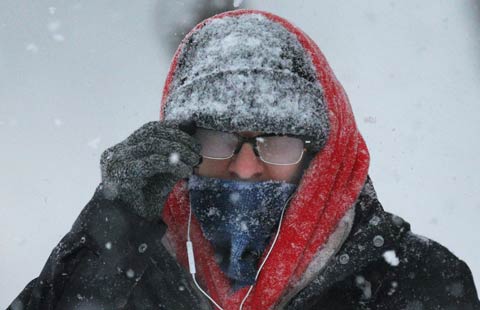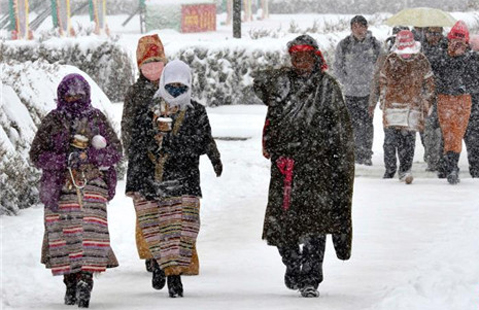BuzzFeed scores with Asians
Updated: 2015-02-13 11:46
By Niu Yue in New York(China Daily USA)
|
||||||||
Outreach by the Internet news service grows rapidly among target ethnic groups nationwide
"Actually, I am not that good at math," said Jenny Yang, an Asian-American comedian in a video called "Ask an Asian", made for BuzzFeed, the Internet news media site, on Jan 30. The video answered 11 questions selected out of around 7,000 - mostly about Asian stereotypes - on one of BuzzFeed's Facebook pages.
So far the video had drawn more than 2.5 million views on Facebook, 730,000 on Youtube and 65,000 likes.
"BuzzFeed is like the 'network television' for the Internet generation," said the Taiwan-born, southern California-raised comedian. "It has been so great to have my work seen by so many people."
Her success is just one example of BuzzFeed's outreach to Asian Americans, not to mention other ethnic minorities in the United States. The ratio between the number of Asians among BuzzFeed's visitors and the number of Asians on the US internet overall has grown by 36 percent over the past year, according to Quantcast.
"There's a tradition in American media of consigning minority groups to specialty publications, subsites and special verticals," said Ben Smith, BuzzFeed editor-in-chief, in a note to his staff on Feb 3. "For us, that would have been a missed opportunity."
Asian Americans "have been kind of a dormant demographic that wants to be catered to," said Tetsuro Shigematsu, a Canadian radio broadcaster, comedian and filmmaker, who is conducting research on social media as a PhD student at the University of British Columbia.
He cited as examples the popularity of ABC's Fresh Off the Boat, a sitcom based on the life of Chinese immigrant Eddie Huang, and "Linsanity," the popularity of Jeremy Lin, an NBA player from Taiwan.
"We are seeing an exciting time of change," Shigematsu said, "from previously being a rather invisible and marginalized community in terms of media visibility to crossing a threshold of emergence."
BuzzFeed has kept a racially diverse editorial group in order to reach a more diverse audience, Smith wrote last October. As of Sep 2014, 11.3 percent of BuzzFeed's US employees were Asian. The overall percentage of Asians in the US was 4.8, according to the 2010 US Census.
The website has also sought out Asian American-related material.
"BuzzFeed approached me to help with their videos that involved Asian American content and I was happy to help," said Yang. "A big part of our work is making sure what we do is truthful and funny. There really isn't any other way to describe our process."
Content targeting Asian Americans includes the iconic "BuzzFeedy lists" with humorous items like "22 Signs You Grew Up with Immigrant Chinese Parents" or "17 Reasons Why Asian American (or Any Other Western Asian) Men Make the Best Boyfriends."
Meanwhile, in some other sections, where more serious topics are touched upon, contributors talk about "The Pain of Casual Racism" and "The Forgotten Story of Classic Hollywood's First Asian-American Star."
"People are choosing to go to sites that they are sure already reaffirm their point of view, lifestyle and culture," said Larry Moskowitz, a strategist with Gravity Media, a public relations and marketing firm.
BuzzFeed "aims to create a sense of self-identity, and after watching it, people will say 'Oh! It's me!' and then they will share it on social network," said Niu Muge, a Columbia Journalism School student who studied BuzzFeed and co-founded Channel C, a Youtube Channel on Chinese students studying abroad.
"The internet is, in some ways, organized around identity," Smith said. "News and entertainment companies have often alienated or failed to reach consumers who don't hold the characteristics of the straight, white everyman."
As for stereotypes, misunderstanding and even racism, Jenny Yang said at the end of her "Ask an Asian" video: "I think you all need to get out more. Ask some Asians. We are out there."
Lu Huiquan in New York contributed to this report.
Most Viewed
Editor's Picks

|

|

|

|

|

|
Today's Top News
China to import more iron ore from Vale
Mexico makes moves to attract more Chinese tourists
Brazil, Peru and China to specify railway details
Growing up recluse in a dazzling world of Manhattan
Apple studies self-driving car: auto industry source
Second-longest railway built overseas by China rolls out
Graft buster publishes corruption cases in environmental sector
2 deadly shootings within hours in Copenhagen
US Weekly

|

|















